Two basic types of nerve cells
Neurons-transmit electrical signals
Neuroglia (glial cells)-support the neurons
4 types of neuroglia-CNS
Astrocytes
Microglial cells
Ependymal cells
Oligodendrocytes
2 types of neuroglia-PNS
Satellite cells
Schwann cells
Neuroglia compared to Neurons
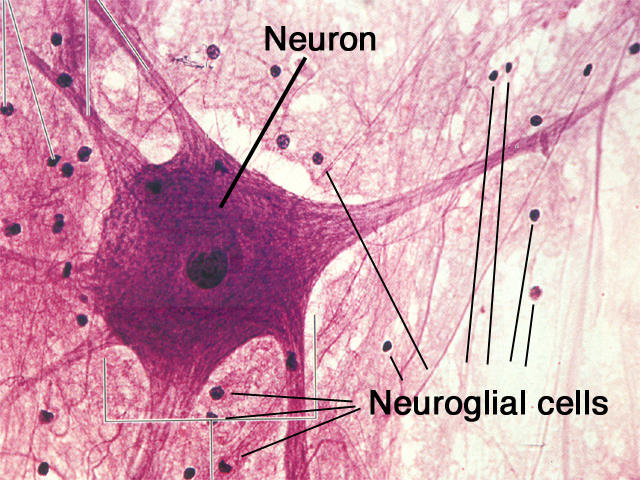
Neuroglia are smaller, darker then neurons
they outnumber neurons 10 to 1
making up at least 50% of brain and spinal cord mass
Astrocytes-CNS

"star-shaped"
most abundant and versatile
Jobs: support and brace neurons, guide young neurons, synapse formation, adjust capillary permeability, adjust "chemical environment" by absorbing ions, information processing
Microglial cells-CNS

oval cells with long, thorny processes
Jobs: monitor health of neurons, transform into a macrophage (**because cells of immune system are denied access to CNS)
Ependymal cells-CNS

can be squamous, cuboid, or columnar, most are ciliated
Jobs: line central cavities of brain and spinal cord, cilia help to circulate CSF
Oligodendrocytes-CNS

Job: wrap around neurons of CNS, insulating them and forming myelin sheath
**cannot regenerate like schwann cells
*does not wrap around Nodes of Ranvier
Satellite cells-PNS
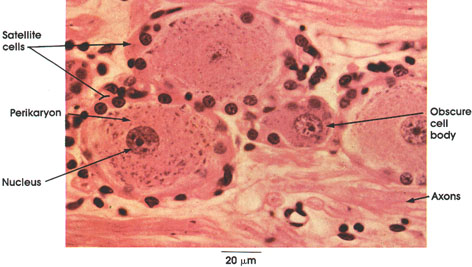
*surrounds neuron cell bodies of PNS
Job: is thought to help guide young neurons like the astrocytes
Schwann cells-PNS

AKA neurolemmocytes
Jobs: wrap around nerve fibers in PNS forming myelin sheath; similar to oligodendrocytes of CNS; regenerate damaged peripheral fibers
Neurons (nerve cells) characteristics
conduct nerve impulses, in CNS and PNS, last a lifetime, have high metabolic rate (O2)
**Amitotic-once they reach maturity, they lose ability to divide; except the olfactory epithelium and some hippocampal regions that have stem cells
Nerve cell anatomy parts
Neuron cell body
Nissl body (rough ER)
Microtubules and Neurofibrils
Inclusions
Dendrites and Axons
Neuron Cell body
AKA (ALSO KNOWN AS) perikaryon or soma
do not have centrioles, which is why they are amitotic
Most are in CNS, in receptive region
Nissl Bodies

AKA Rough ER
AKA chromatophilic substance (because it stains darkly with basic dyes)
Microtubules and Neurofibrils
help maintain shape and integrity of cell
Inclusions

little packages of metabolic byproducts that accumulate in the cell
Some are pigments: melanin and lipofuscin
Melanin inside inclusions
red iron-containing pigment
Lipofuscin inside inclusions
golden-brown pigment that accumulates with age
AKA "aging pigment"
Nuclei
clusters of nerve cell bodies in CNS
Ganglia
clusters of nerve cell bodies in PNS
Processes of nerve cell (neuron) anatomy
CNS contains both neuron cell bodies and their processes; tracts
PNS contains mostly neuron processes; nerves
Bundles of neuron processes in the CNS
tracts
Bundles of neuron processes in the PNS
nerves
2 Types of Nerve cell processes
Dendrites
Axons
Dendrites
short, branching
main receptive or input regions with graded potential
**Motor neurons have 100's--dendritic spines are points of synapses with other neurons
Graded potential
NOT action potentials, but are a type of short-distance signal
Axons
**Conducting region of neuron that sends action potentials
1 per neuron, can have many branches
starts with axon hillock, a funnel-shaped region by cell body
long ones (3-4 ft in leg) are called nerve fibers
branches are called axon collaterals
ends in thousands of terminal branches (telodendria) with knob-like end called an axon terminal
What happens when axons get cut
axon contains the same organelles found in the dendrites and cell body with 2 exceptions (no nissl bodies AKA rough ER, no golgi apparatus)
**so axons will quickly decay if cut
Axonal Transport
single bidirectional transport system that brings stuff up and down axons
*motor protein that uses ATP
*goes along microtubules at 15 inches per day
directions: retrograde and anterograde
Retrograde
transport back to the cell body
**polio, herpes simplex and tetanus toxin use this to read cell body
Anterograde
toward axon terminals
Myelin Sheath and Neurolemma
Jobs: whitish fat covers long nerve fibers, protects and electrically insulates nerve fiber, increases speed of nerve impulse transmission
*dendrites always unmyelated, axons either way
Myelin sheath and neurolemma composition-PNS
Schwann cells make it up, Nodes of Ranvier (gaps in between these cells), can wrap around 15 nerve cell axons
Gray Matter-CNS
contains mostly nerve cell bodies and unmyelinated fibers
Myelin sheath and neurolemma composition-CNS
Oligodendrocytes make it up, can wrap around 60 nerve cell axons with widely spaced nodes of ranvier
White Matter-CNS
dense collections of myelinated fibers
Classification of Neurons-Structural
Multipolar neurons
Bipolar neurons
Unipolar neurons
Multipolar neurons

have 3 or more processes
*most common type! (about 99%)
Bipolar neurons

2 processes-cell body in middle and dendrite
*rare (retina of eye and olfactory mucosa)
Unipolar neurons
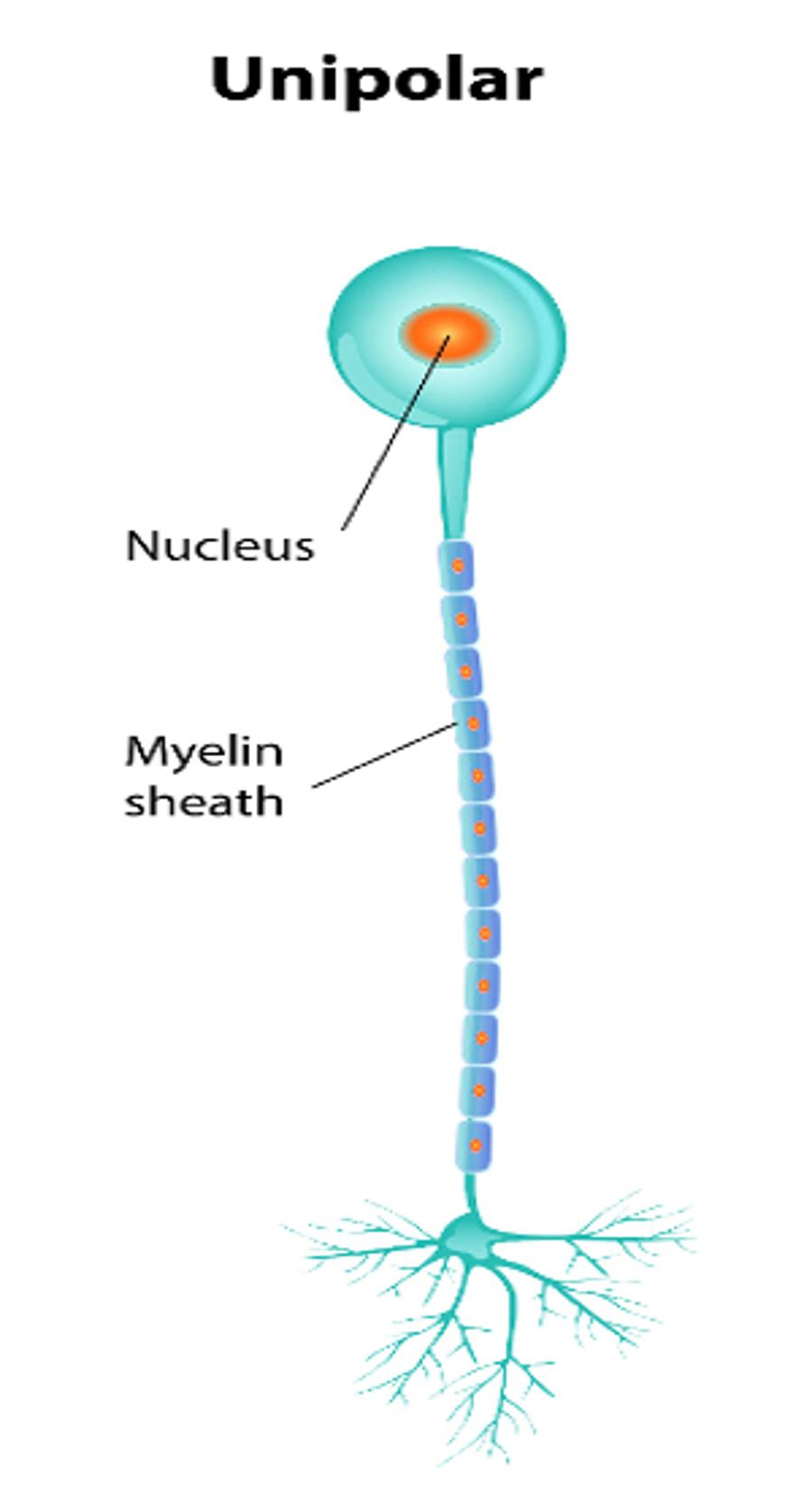
1 short process emerging from cell body and divides into peripheral and central processes
*found in ganglia or PNS used as sensory neurons
Classification of Neurons-Functional
Sensory (afferent) neurons
Motor (efferent) neurons
Interneurons or association neurons
Sensory (Afferent) neurons
transmit impulse into CNS
unipolar
located in PNS...ganglia
Motor (Efferent) neurons
carry impulse away from CNS
multipolar
cell bodies in CNS...nuclei
Interneurons or Association neurons
between motor and sensory neurons
multipolar and in CNS
Neurophysiology Components
Voltage
Current
Resistence
Voltage
"potential energy" from separation of charges
measured in volts or with tiny stuff like a nerve, millivolts
Current
flow of electrical charge from one point to another
used to do work
Resistance
hindrance to charge flow
Ohm's Law
Current (I) = Voltage (V) / Resistance (R)
Electrical currents reflect flow of ions across cell membranes
Plasma membranes maintaining membrane potential use ion channels
**Open channels allow ions to move along their electrochemical gradients
Types of Charged Channels
Chemically (Ligand) gated ion channels
Voltage gated ion channels
Mechanically gated ion channels
Leak channels

Chemical (Ligand) gated ion channel
**found on nerve dendrites and cell bodies
transmembrane--open or close in response to a chemical neurotransmitters like ligands in neurons, help react quickly to messages
**uses lock and key fit, site far from channel
ion permeability changes, let potassium, sodium, calcium pass through to evoke intracellular electrical signal
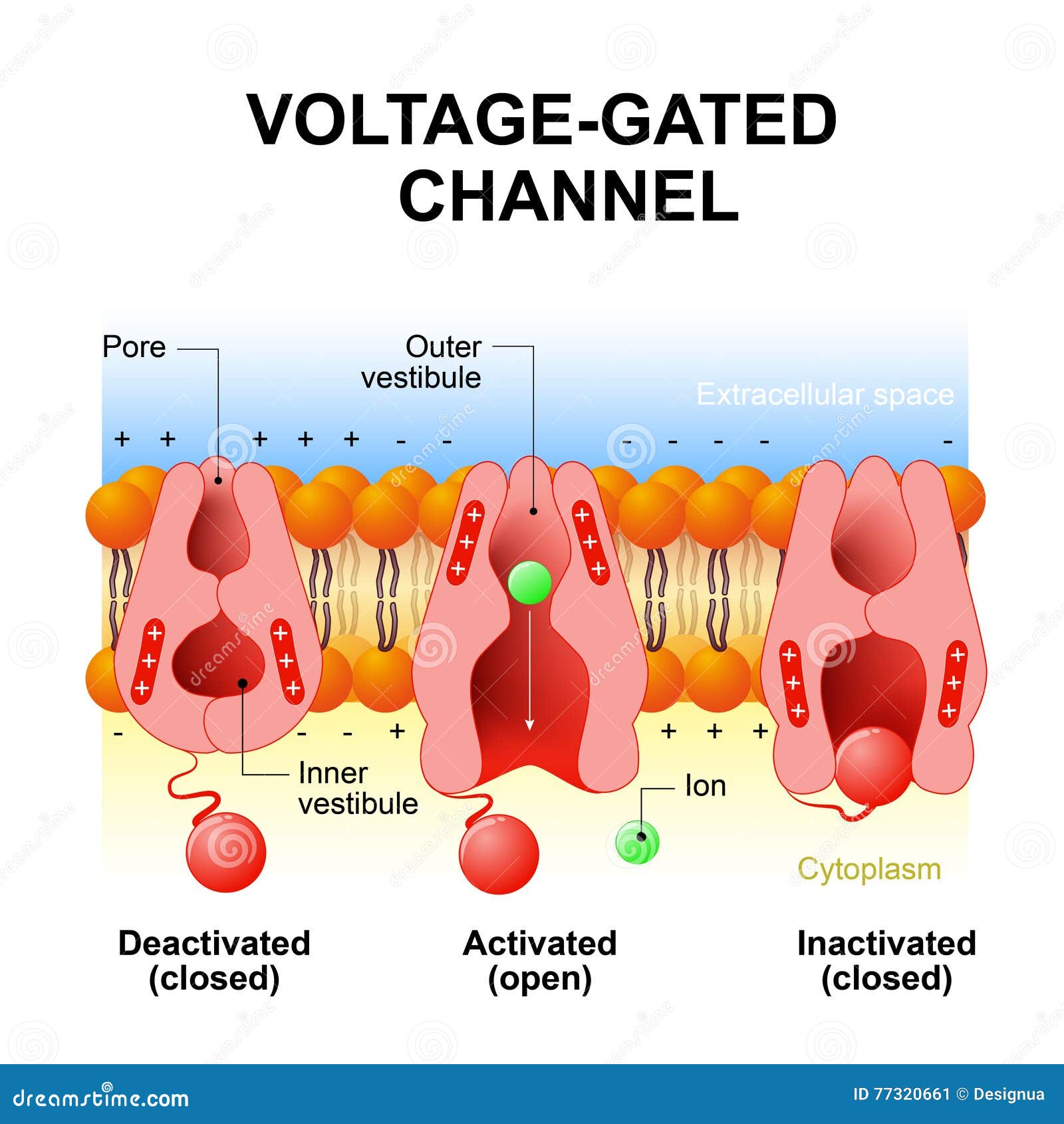
Voltage gated ion channels
**Found on nerve axons and axon hillock
**rely on difference in membrane potential
Change potential to let Action potentials occur
Starts at a resting potential with Sodium-potassium ATPase
*reverses resting membrane potential, potassium leaves, which removes positive charges
closes channel by ball-and-chain method
RESULT: more negative cell and an action potential
Resting Membrane Potential
*graded potential
+ and - charges inside and outside the nerve cell, greater negative charge inside
*leak channels allow ions to diffuse down concentration gradients--many more potassium leak channels than sodium leak channels--so more permeable to potassium ions
sodium and potassium gradients, more sodium ions outside, more potassium ions inside
**measured using a voltmeter, on average the charge is -70 millivolts
Depolarization and Hyperpolarization
*graded potentials for short distances
*action potentials for long distances
anything that produces a change in ion permeability can change membrane potential
Depolarization
loss of difference in charge in a nerve cell where sodium ions enter cell
Hyperpolarization
increase in potential difference
Spread and Decay of graded potentials

Action Potential
**send signals over long distances
AP transmission and generation in skeletal muscle cells and neurons are the SAME.
**To have this occur, enough voltage gated channels need to open, graded potentials at the axon hillock transition into action potentials
**NO dissipation over distance, unlike graded potentials
**ALL of these of from -70mV to +30mV
Depolarization of an Action Potential
restores resting electrical conditions, but does NOT restore resting ionic conditions by Sodium-potassium pump
Amounts of sodium needed for Action potential is a 0.012% change in intracellular Na+ concentrations
Saltatory Conduction
in myelinated nerves and motor neurons
action potential is propagated along axon's entire length from each node of ranvier and is self-propagating
30x faster than continuous conduction seen in unmyelinated axons
Propagation of an Action Potential
reversal of charges across a membrane, positive charge from axon hillock to the next segment of axon to trigger action potential in the next axon, then axon hillock returns to resting membrane potential
---action potential travels from one axon to the next --with action potential also moving from one segment of an axon to the next
Graded Potential
positive charge
dissipates over distance, Action potentials go from -70mV to a range of values up to +30mV
Refractory Period of an action potential propagation
**Cannot trigger an action potential going backwards on the gradient
--the ball-and-chain method where the ball closes off the channel so no charge can go through it again...until they reset for another action potential
Relationship between stimulus strength and action potential frequency
**any voltage that is NOT strong enough to open enough sodium channels will NOT generate an action potential
*increasing axon width will also increase action potential speed
*once threshold is reached for an action potential, the stronger the stimulus, the more frequently the action potentials are generated
Absolute Refractory Period in Action Potentials
**when sodium channels open until sodium channels reset
*this patch of membrane can NOT respond to another stimulus
Relative Refractory Period in Action Potentials
**most of the sodium channels have closed
*still repolarizing, but a STRONG stimulus can cause an action potential
Action Potential in Bare Plasma Membrane
...
Action Potential in Unmyelinated Axons
https://www.youtube.com/watch?v=pbg5E9GCNVE
Action Potential in Myelinated Axons
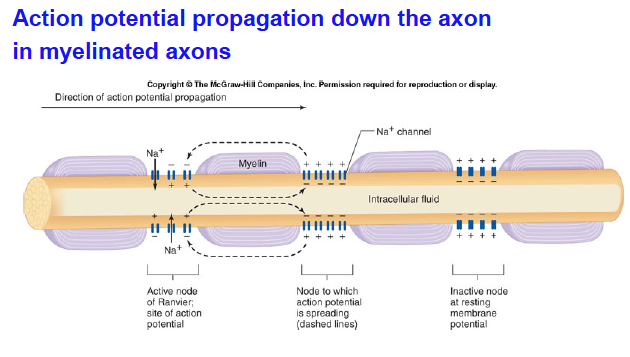
MS-Multiple Sclerosis
autoimmune disease-due to myelin sheath in CNS being gradually destroyed and hardened (sclerosis)
axons are not affected though
onset in young adults!
1st sign is visual (temporary blindness)
problems controlling muscles (weak, clumsy)-from peripheral motor nerve demyelination
Synapse (tiny gaps) Types
Electrical
Chemical
Electrical Synapse
**less common
neurons joined like this are electrically coupled
action potential transmission is very rapid
unidirectional OR bidirectional
Chemical Synapse
transmit action potentials to postsynaptic neurons by specific chemicals called neurotransmitters
*inside synaptic vesicles at axon terminals
neurotransmitters shoot across a tiny gap called a synaptic cleft (30 to 50nm wide)
*only unidirectional
Excitatory Post Synaptic Potentials
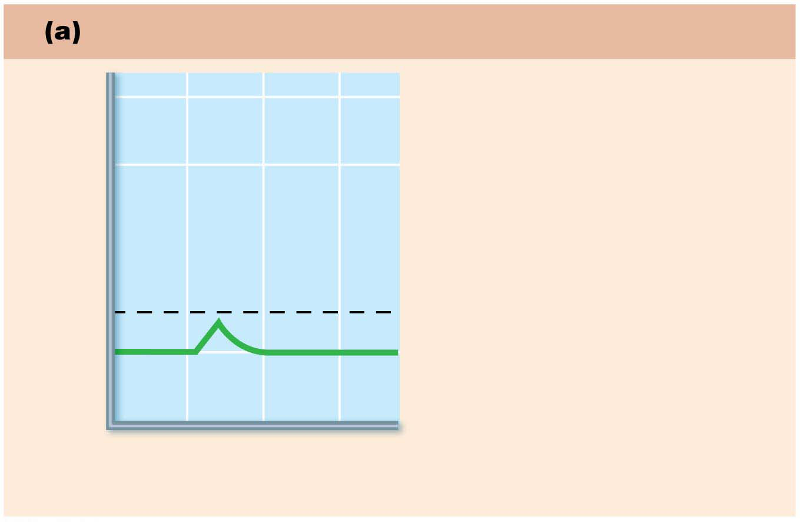
Inhibitory Post Synaptic Potentials
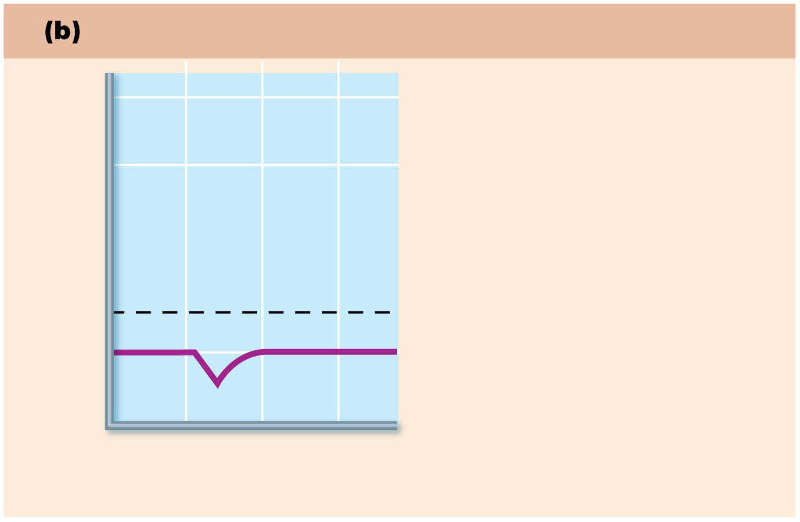
Action potential vs. Graded potential!!
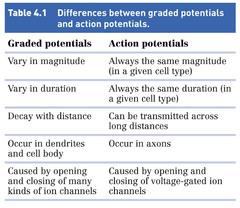
VERY important for test!
Types of Neurotransmitters
Acetylcholine
Norepinephrine
Dopamine
Serotonin
Acetylcholine
nicotinic and muscarinic subtypes
*when prolonged, you can get titanic muscle spasms because acetylcholinesterase is blocked (sarin nerve gas and insecticides can do this)--also inhibited by the botulism toxin
Alzheimers and Acetylcholine connection
less overall acetylcholine with people who have this disease
Norepinephrine
release enhanced by amphetamines
removal from synapse blocked by cocaine and antidepressants
**low levels in depression
Dopamine
release and removal similar to Norepinephrine
**low levels in Parkinson's disease
Serotonin
acts like a brake on a bicycle
blocked by LSD and Prozac (treats depression)
blocking an inhibitor makes it activate!
Differences between action potentials and graded potentials
